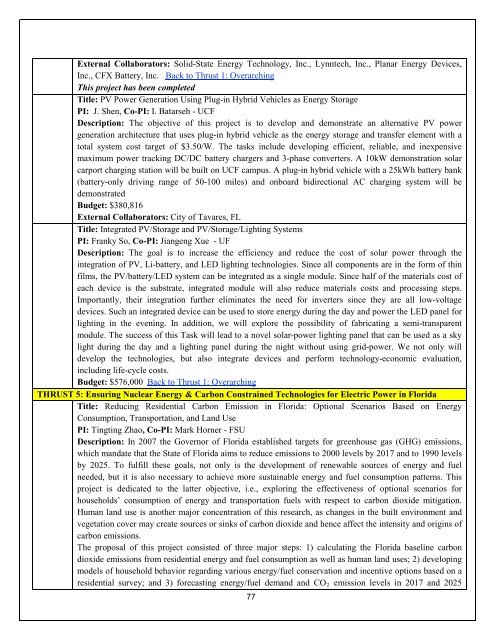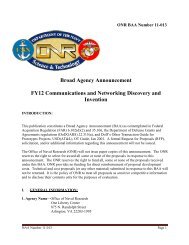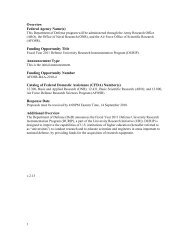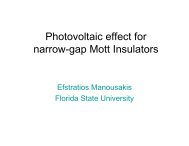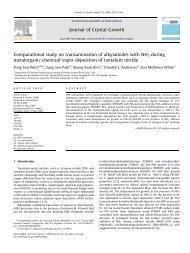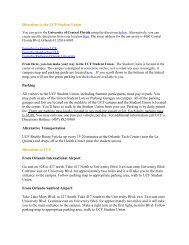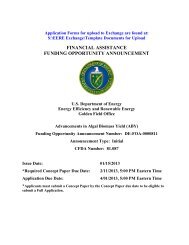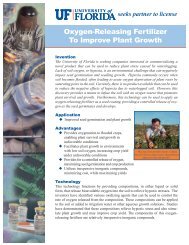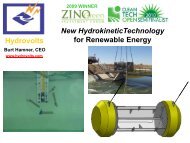Annual Report- Part III - Florida Energy Systems Consortium
Annual Report- Part III - Florida Energy Systems Consortium
Annual Report- Part III - Florida Energy Systems Consortium
You also want an ePaper? Increase the reach of your titles
YUMPU automatically turns print PDFs into web optimized ePapers that Google loves.
External Collaborators: Solid-State <strong>Energy</strong> Technology, Inc., Lynntech, Inc., Planar <strong>Energy</strong> Devices,Inc., CFX Battery, Inc. Back to Thrust 1: OverarchingThis project has been completedTitle: PV Power Generation Using Plug-in Hybrid Vehicles as <strong>Energy</strong> StoragePI: J. Shen, Co-PI: I. Batarseh - UCFDescription: The objective of this project is to develop and demonstrate an alternative PV powergeneration architecture that uses plug-in hybrid vehicle as the energy storage and transfer element with atotal system cost target of $3.50/W. The tasks include developing efficient, reliable, and inexpensivemaximum power tracking DC/DC battery chargers and 3-phase converters. A 10kW demonstration solarcarport charging station will be built on UCF campus. A plug-in hybrid vehicle with a 25kWh battery bank(battery-only driving range of 50-100 miles) and onboard bidirectional AC charging system will bedemonstratedBudget: $380,816External Collaborators: City of Tavares, FLTitle: Integrated PV/Storage and PV/Storage/Lighting <strong>Systems</strong>PI: Franky So, Co-PI: Jiangeng Xue - UFDescription: The goal is to increase the efficiency and reduce the cost of solar power through theintegration of PV, Li-battery, and LED lighting technologies. Since all components are in the form of thinfilms, the PV/battery/LED system can be integrated as a single module. Since half of the materials cost ofeach device is the substrate, integrated module will also reduce materials costs and processing steps.Importantly, their integration further eliminates the need for inverters since they are all low-voltagedevices. Such an integrated device can be used to store energy during the day and power the LED panel forlighting in the evening. In addition, we will explore the possibility of fabricating a semi-transparentmodule. The success of this Task will lead to a novel solar-power lighting panel that can be used as a skylight during the day and a lighting panel during the night without using grid-power. We not only willdevelop the technologies, but also integrate devices and perform technology-economic evaluation,including life-cycle costs.Budget: $576,000 Back to Thrust 1: OverarchingTHRUST 5: Ensuring Nuclear <strong>Energy</strong> & Carbon Constrained Technologies for Electric Power in <strong>Florida</strong>Title: Reducing Residential Carbon Emission in <strong>Florida</strong>: Optional Scenarios Based on <strong>Energy</strong>Consumption, Transportation, and Land UsePI: Tingting Zhao, Co-PI: Mark Horner - FSUDescription: In 2007 the Governor of <strong>Florida</strong> established targets for greenhouse gas (GHG) emissions,which mandate that the State of <strong>Florida</strong> aims to reduce emissions to 2000 levels by 2017 and to 1990 levelsby 2025. To fulfill these goals, not only is the development of renewable sources of energy and fuelneeded, but it is also necessary to achieve more sustainable energy and fuel consumption patterns. Thisproject is dedicated to the latter objective, i.e., exploring the effectiveness of optional scenarios forhouseholds’ consumption of energy and transportation fuels with respect to carbon dioxide mitigation.Human land use is another major concentration of this research, as changes in the built environment andvegetation cover may create sources or sinks of carbon dioxide and hence affect the intensity and origins ofcarbon emissions.The proposal of this project consisted of three major steps: 1) calculating the <strong>Florida</strong> baseline carbondioxide emissions from residential energy and fuel consumption as well as human land uses; 2) developingmodels of household behavior regarding various energy/fuel conservation and incentive options based on aresidential survey; and 3) forecasting energy/fuel demand and CO 2 emission levels in 2017 and 202577


